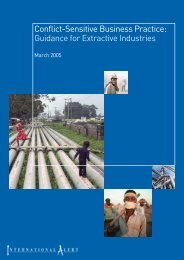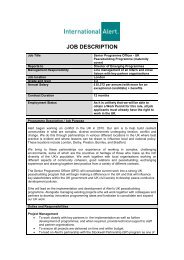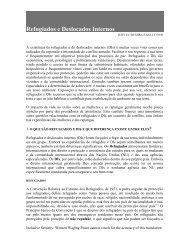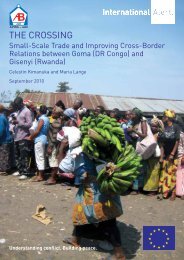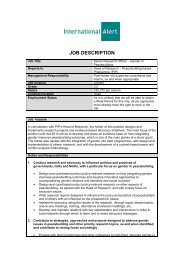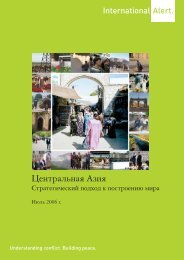strengthening the economic dimensions of ... - International Alert
strengthening the economic dimensions of ... - International Alert
strengthening the economic dimensions of ... - International Alert
Create successful ePaper yourself
Turn your PDF publications into a flip-book with our unique Google optimized e-Paper software.
4 <strong>International</strong> <strong>Alert</strong><br />
Economic context<br />
At <strong>the</strong> time <strong>of</strong> <strong>the</strong> signing <strong>of</strong> <strong>the</strong> CPA Nepal was one <strong>of</strong> <strong>the</strong> least developed countries in <strong>the</strong> world. 9<br />
The majority <strong>of</strong> <strong>the</strong> population was dependent on subsistence farming, although many family farms<br />
were too small to provide sufficient income. Land ownership was concentrated in <strong>the</strong> hands <strong>of</strong> an<br />
elite. GDP was made up <strong>of</strong> industry (21.6 percent) and services (37.8 percent), with manufacturing<br />
and tourism contributing less than 10 percent each. The conflict itself had a significant impact<br />
on <strong>the</strong> economy. It disrupted transport links, shut down factories and gave rise to widespread<br />
extortion in <strong>the</strong> industry sector, bringing <strong>the</strong> economy to a virtual standstill. 10<br />
In 2011 agriculture contributed 33 percent <strong>of</strong> GDP and this share was expected to grow. Industrial<br />
development had been slow due to power shortages, frequent strikes, insecurity and poor<br />
infrastructure. The service sector was driven by a gradual rise in tourism, telecommunications and<br />
social services. The fertile Terai lowland had <strong>the</strong> potential to benefit Nepal through cross-border<br />
trade with neighbouring India. The region produced wheat and pulses and was also home to agrobased<br />
industries such as rice mills and tobacco factories. Yet, <strong>the</strong> trade deficit with India continued<br />
to be one <strong>of</strong> <strong>the</strong> country’s <strong>economic</strong> woes. The hilly and mountainous areas, including <strong>the</strong> region<br />
from where <strong>the</strong> Maoist civil war had sprung, remained <strong>the</strong> least developed and most poverty<br />
stricken areas in Nepal.<br />
9 United Nations Development Programme (UNDP) (2006). Human development report 2006 – Beyond scarcity: Power, poverty and <strong>the</strong> global<br />
water crisis. New York. Available at http://hdr.undp.org/en/media/HDR06-complete.pdf<br />
10 <strong>International</strong> <strong>Alert</strong> (2006). Local business, local peace: The peacebuilding potential <strong>of</strong> <strong>the</strong> domestic private sector, Section 2: Nepal case<br />
study. Available at http://www.international-alert.org/resources/publications/local-business-local-peace





